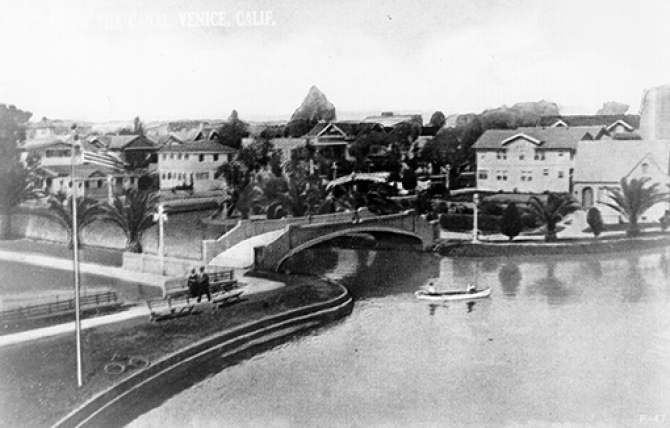What would one day become the intersection of Main and Windward in Venice was at one time a picturesque landscape of canals dreamed up by Abbot Kinney. Security Pacific National Bank Collection, 1922.
From the pueblo days of Zanja Madre to Mulholland’s aqueduct to Abbot Kinney’s canals, the history of Los Angeles and water is one of remarkable achievement, but at times marked by significant failure. It is in the spirit of celebration of the river’s discovery by the Spanish, that this exhibit and accompanying book explores the quest for and deliverance of water to Los Angeles and commemorates our city’s monuments to this achievement.
Water. Vital for all forms of known life. And for the life of a city. From the earliest days of El Pueblo de la Reyna de los Ángeles to today’s modern metropolis, Los Angeles owes its life to this essential resource.
Throughout history, the world’s earliest cities can trace their roots to their waterways. London has the Thames. Paris has the Seine. Cairo has the Nile. Rome traces its mythological creation, to its river, the Tiber. Tiberinus, a god depicted with streams of water flowing from his hair and beard, ensured the safe passage of Romulus and Remus after the twin brothers were placed in a basket and set on the river, Tiber. Where the basket was caught by the roots of a fig tree and Romulus and Remus were rescued and nursed by a she-wolf, is the site of present-day, Rome.
Here in the United States, Washington, D.C. has the Potomac. Chicago has its namesake river. New York City would brag that it has three rivers, the Hudson, East, and Harlem. But try and trace present day Los Angeles, the largest and most populous city in the western U.S., to its river and you might find yourself up the proverbial creek without a paddle. Yet, that history, with a bit of its own mythology, is here.
From the earliest days as a source of food and water for the Tongva people to the arrival of the Spanish in 1769 who named it El Rio de Nuestra Senora La Reina de Los Ángeles de Porciúncula, (a title derived from an approaching Franciscan religious celebration), the river nurtured its inhabitants until the city’s growth threatened to exceed the river’s ability to sustain it around 1900.
Enter Los Angeles’ Tibernius, William Mulholland, and his deliverance of the waters via the Los Angeles Aqueduct in 1913. At the aqueduct’s opening ceremony and the water’s arrival, Mulholland’s pronouncement “There it is. Take it,” sounds like a passage straight from the Old Testament. Yet, it fulfilled his earlier prophecy that “whoever brings the water will bring the people.” But, like a modern-day Greek tragedy, hubris would write the last chapter for Mulholland. Twelve hours after declaring it “safe,” one of his monumental structures, a dam forty miles north of the city named after Saint Francis, the patron saint of animals and the natural environment, would collapse claiming the lives of over 400 innocents in 1928.
Unpredictably too, the Los Angeles River would lash out at its citizens, sending a destructive force of water across its flood plain with the winter rains as it had during the great flood of 1862 and the catastrophe of February 1938, which killed more than 100 people. It was then that the Army Corps of Engineers began to encase the river’s bed and banks in concrete, cementing an undignified end to the river honored as “Our Lady” a century and a half earlier.
From the pueblo days of Zanja Madre to Mulholland’s aqueduct, to Abbot Kinney’s canals, the history of Los Angeles and water is one of remarkable achievement. It is in the spirit of celebration of the river’s discovery by the Spanish, that this exhibit and accompanying book explores the quest for and deliverance of water to a city in a semi-arid climate with an unreliable rainfall. It also commemorates our city’s monuments to this achievement from the fountains in our public squares to the most classic of symbols of southern California living, the swimming pool. Some of these monuments have been lost, paved over, or simply turned off and left to run dry. Others, like the Los Angeles River, are experiencing a rebirth, a new sense of purpose and pride. In a more hostile environment of climate change, drought and wildfires, it is vital that we understand our past, and decide whether we write the next chapter of our city’s history by confronting the challenges, as our city’s forebears did, or surrendering to the elements.
Dennis Kopp
Board Member, Photo Friends
